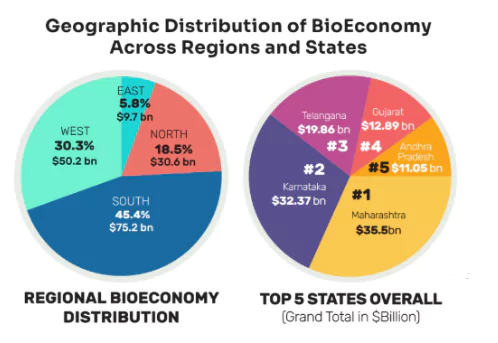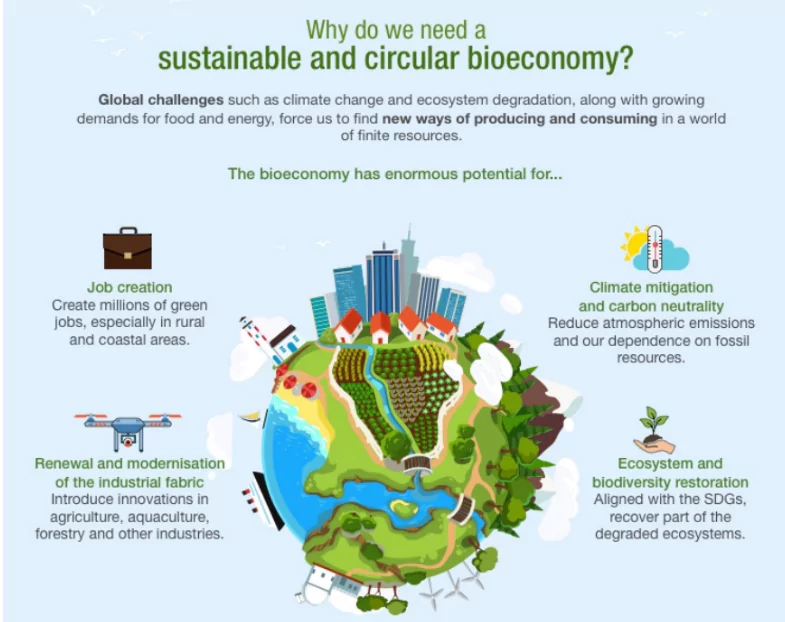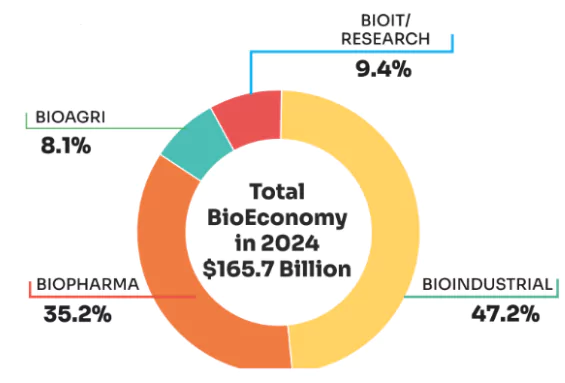Recently, the India BioEconomy Report was released by the Department of Biotechnology.
Key Insights of the India Bioeconomy Report 2025
- Current Market Size and Growth:
- India’s bioeconomy grew from $86 billion in 2020 to $165 billion in 2024, nearly doubling in just five years.
- The projected growth is expected to reach $300 billion by 2030 and further expand to $1 trillion by 2047 with a CAGR of 10.6% (2024–30) and 7.5% (2030–47).
- Contribution to GDP:
- In 2024, India’s bioeconomy contributed over 4.2% of the country’s GDP.
- Though this figure is comparable to the United States and China, it is significantly lower than countries like Spain and Italy, where the bioeconomy accounts for over 20% of GDP.
- Sector-Wise Contribution:
- BioIndustrial (47.2%): Largest segment ($78.2 billion), driven by biofuels, enzymes, and bioplastics.
- BioPharma (35.2%): $58.4 billion, led by vaccines, diagnostics, and therapeutics.
- BioServices (9.4%): Fastest-growing ($15.6 billion), including contract research and AI-driven bioinformatics.
 BioAgri (8.1%): $13.5 billion, dominated by Bt Cotton and biofertilizers.
BioAgri (8.1%): $13.5 billion, dominated by Bt Cotton and biofertilizers.
- Increase in Companies and Employment:
- The number of companies operating in the bioeconomy increased by 90% in the last three years, rising from 5,365 in 2021 to 10,075 in 2024.
- By 2030, this number is expected to double again, with the sector projected to employ close to 35 million people.
- Geographical Disparities:
- Five states — Maharashtra, Karnataka, Telangana, Gujarat, and Andhra Pradesh — accounted for over two-thirds of the total value generated in the bioeconomy.
- The eastern and northeastern regions contributed less than 6% of the total value, highlighting regional imbalances.
- Startup Ecosystem
- Biotech startups crossed 10,075 in 2024 (from 50 in 2012).
- 1,544 new startups added in 2024, with Maharashtra, Karnataka, and Telangana leading.
- BIRAC (Biotechnology Industry Research Assistance Council) supported 800+ products, 1,300+ IP filings, and INR 5,500 crore in investments.
What is Bioeconomy?
- According to the United Nations Food and Agriculture Organisation (FAO), the bioeconomy is “the production, use and conservation of biological resources, including related knowledge, science, technology, and innovation to provide information, products, processes and services to all economic sectors with the aim of moving towards a sustainable economy”.

Sectors of India’s Bioeconomy
- Industrial Biotechnology: Nearly 50% of the bioeconomy’s value in 2024.
- Key Areas:
- Biofuels: Ethanol production through fermentation of sugarcane, corn, and other crops.
- Bioplastics: Development of biodegradable plastics as an alternative to petroleum-based plastics.
- Bio-based Chemicals and Enzymes: Replacement of conventional chemicals with sustainable, bio-derived alternatives.
- Pharmaceuticals and Healthcare: Accounts for around 35% of the bioeconomy’s total value.
- Key Areas:
- Vaccines: Major contributor, with India being a global leader in vaccine production.
- Biomedicines: Development of drugs and therapies derived from bioresources.
- Diagnostics and Therapeutics: Innovative biotechnological solutions for disease prevention and treatment.
- Agricultural Biotechnology: Significant but underutilized due to regulatory hurdles, particularly with genetically modified (GM) crops.
- Key Areas:
- Crop Improvement: Use of biotechnology for developing high-yield, drought-resistant, and pest-resistant crops.
- Biofertilizers and Biopesticides: Sustainable alternatives to chemical fertilizers and pesticides.
- Precision Agriculture: Leveraging bioinformatics and AI for better yield prediction and resource management.
- Research, Bioinformatics, and IT: The fastest-growing segment in 2024, contributing significantly to R&D and technological innovations.
- Key Areas:
- Biotech Software Development: Platforms for data analysis and drug discovery.
- Clinical Trials and Drug Research: Use of bioinformatics to accelerate research processes.
- Synthetic Biology: Development of genetically engineered microorganisms with desired traits.
- Environmental Biotechnology: Emerging sector with growing importance.
- Key Areas:
- Waste Management and Bioremediation: Use of microorganisms to treat industrial waste and environmental pollutants.
- Climate-Resilient Technologies: Bio-based solutions to mitigate climate change impacts.
 Marine and Space Biotechnology: Niche but high-growth potential.
Marine and Space Biotechnology: Niche but high-growth potential.-
- Key Areas:
- Marine Biotechnology: Exploration of marine bioresources for pharmaceuticals, biofuels, and biomaterials.
- Space Biotechnology: Application of biotech solutions for sustaining life in space and developing innovative space materials.
- Bio-Manufacturing and Bio-based Textiles: Emerging segment with high future potential.
- Key Areas:
- Bio-fabricated Textiles: Sustainable alternatives to conventional fabrics.
- Bio-manufacturing Platforms: Production of bio-based chemicals and materials.
Major Scientific Breakthroughs
- GenomeIndia Project
- Completed whole genome sequencing of 10,074 Indians from 99 diverse communities.
- Created the first “Reference Genome for the Indian Population”, enabling personalized medicine tailored to India’s genetic diversity.
- Led by: Department of Biotechnology (DBT), with 20 national institutes collaborating.
- Indigenous CAR-T Cell Therapy for Cancer
- Launch of Qartemi, India’s first indigenous CAR-T cell therapy for B-cell non-Hodgkin lymphoma.
- Developed by Immunel Therapeutics, priced at ₹35–50 lakh (vs. global cost of ~₹3–4 crore).
- Nafithromycin – India’s First Indigenous Antibiotic Against AMR
- Developed by: Wockhardt, with support from BIRAC.
- Targets: Community-Acquired Bacterial Pneumonia (CABP) caused by drug-resistant bacteria.
- Efficacy: 10x more effective than azithromycin, with high clinical cure rates.
- Advanced Vaccines
- PneumoShield 14 (Abbott): 14-valent Pneumococcal Conjugate Vaccine for children, covering more strains than existing vaccines.
- HILLCHOL (Bharat Biotech): Single-dose oral cholera vaccine, addressing global shortages.
- Cadiflu Tetra (Cadila): Quadrivalent influenza vaccine using nanoparticle technology.
- Ethanol Blending Program
- Achievement: 15% ethanol blending achieved in 2024 (20% by 2025).
- Reduced fossil fuel imports; India is now the 3rd-largest ethanol producer globally with 16.2 billion liters of bioethanol capacity (from sugarcane, agricultural waste).
- Biofortified Crops & Climate-Resilient Agriculture
- Bt Cotton Dominance: Accounts for 76% of BioAgri sector ($10.3 billion).
- Biofertilizers/Biopesticides: Market grew to $1.6 billion (2024), reducing chemical use.
- Indigenous IVF Media for Dairy Farming: “Shashthi” by India Immunologicals cuts IVF costs by 33%, boosting livestock productivity.
- AI-Driven Biotech Innovations
- Bio-Rad’s ddSEQ Kit: Enables single-cell RNA sequencing for cancer/immunology research.
- Neuberg Diagnostics’ Geniee: Personalized genomics platform for disease risk prediction.
- Bio-AI Hubs: Proposed under BioE3 Policy to integrate AI with biomanufacturing.
- Marine and Space Biotechnology
- Marine Bioprospecting: Focus on seaweed cultivation and antimicrobial compounds.
- Space Research: DBT-BIRAC exploring microgravity effects on biomanufacturing.
- Drone-Based Healthcare Delivery
- Skye Air Mobility & CARiTAS Hospital: Launched drone medical supply networks in Kerala, reducing delivery time from hours to 5–7 minutes.
- Global Collaborations
- Global Biofuel Alliance (GBA): Led by India, US, and Brazil to promote sustainable energy.
- Ind-CEPI Mission: Developing vaccines for epidemics (e.g., Bharat Biotech’s Chikungunya vaccine in Phase 2/3 trials).
Why India’s Bioeconomy Needed?
- Sustainable Economic Growth: Bioeconomy leverages renewable biological resources (plants, animals, microorganisms) for industrial processes, reducing dependence on fossil fuels.
- It offers a sustainable alternative for economic growth while minimizing environmental impact.
- Reducing Fossil Fuel Dependency: Biofuels like ethanol and biodiesel provide alternatives to petroleum-based fuels.
- Promoting biofuels supports India’s energy security and helps reduce the carbon footprint.
- Boosting Innovation and R&D: Advancements in biotechnology, bioinformatics, and synthetic biology open up new avenues for drug development, diagnostics, and sustainable industrial processes.
- Employment Generation and Skill Development: The rapid growth of the bioeconomy has the potential to create millions of jobs, particularly in biotechnology, pharmaceuticals, and bio-manufacturing.
- By 2030, it is projected to employ 35 million people, fostering skill development in cutting-edge fields.
- Enhancing Agricultural Productivity: Biotechnology can revolutionize agriculture through genetically modified (GM) crops, biofertilizers, and precision farming.
- These innovations improve crop yields, reduce pesticide use, and ensure food security.
- Environmental Conservation and Waste Management: Bio-based solutions can help in waste management, bioremediation, and reducing pollution.
- The use of bioresources contributes to climate resilience by lowering greenhouse gas emissions.
- Strengthening India’s Global Competitiveness: Establishing India as a global hub for bio-manufacturing and bio-based research will enhance its global standing in biotechnology and allied sectors.
Initiatives Related to Bioeconomy
- BioE3 Policy (Biotechnology for Economy, Environment, and Employment) – 2024
- Aimed at establishing India as a global hub for bio-manufacturing and a major center for biotechnology R&D.
- National Biopharma Mission (NBM): Launched in 2017 with a budget of ₹1,500 crore.
- Objective: To accelerate the development of indigenous biopharmaceuticals and reduce India’s dependency on imports.
- Biotechnology Industry Research Assistance Council (BIRAC): Established in 2012 under the Department of Biotechnology (DBT) to provide funding, mentorship, and incubation support to biotechnology startups.
- Biotechnology Parks and Incubators Scheme: Establishes state-of-the-art biotech infrastructure and incubation centers across India.
- Biodesign Programme: Focuses on developing indigenous medical technologies and devices through innovation.
- Waste to Wealth Mission (under PM-STIAC): Aims to leverage biotechnology to convert waste into valuable resources.
- Deep Ocean Mission (DOM): Includes components related to marine biotechnology for exploring bioresources from deep-sea ecosystems.
Challenges with Bioeconomy in India
- Regulatory Uncertainty and Policy Hurdles: Lack of clear and consistent policies, especially in the approval of genetically modified (GM) crops.
- Example: Despite proven benefits, only Bt Cotton is commercially cultivated, while GM mustard and brinjal face prolonged regulatory delays.
- Limited Acceptance of Genetically Modified (GM) Crops: Reluctance to adopt GM crops due to public perception and environmental concerns.
- GM mustard, developed to enhance oilseed productivity, awaits final regulatory approval despite being cleared by the Genetic Engineering Appraisal Committee (GEAC).
- Inadequate Funding and R&D Investment: Insufficient funding for biotechnology research and innovation, especially in high-risk sectors.
- Only 0.7% of GDP is spent on R&D, with limited focus on bioeconomy-related innovations.
- Infrastructure and Capacity Constraints: Lack of adequate bio-manufacturing infrastructure and high-end research facilities.
- Only five states — Maharashtra, Karnataka, Telangana, Gujarat, and Andhra Pradesh — account for over 67% of bioeconomy output, leaving other regions underdeveloped.
- Technology Transfer and Commercialization Gaps: Difficulty in translating laboratory research into commercially viable bio-based products.
- Many bio-based innovations, especially in biofuels and bioplastics, remain in pilot stages due to lack of scaling-up incentives.
- Low Awareness and Adoption of Bio-Based Solutions: Lack of awareness and technical know-how among farmers and industries about the benefits of bio-based solutions.
- Despite policy push, the adoption of biofertilizers and biopesticides remains low, with most farmers relying on chemical inputs.
- Limited Exploration of Marine and Space Biotechnology: Untapped potential in marine biotechnology and bioresources from deep-sea ecosystems.
- India’s Deep Ocean Mission (DOM) aims to harness marine bioresources, but exploration is still in early stages.
Global BioEconomy Policy Frameworks
| Country |
Policy Framework |
Key Focus Areas |
India’s Alignment |
| USA |
National Biotechnology & Biomanufacturing Initiative (2022) |
- Biomanufacturing
- Climate-smart agri
- AI-driven drug discovery
|
Similar to India’s BioE3 focus on biomanufacturing hubs and Bio-AI. |
| EU |
European Green Deal & BioEconomy Strategy (2023) |
- Circular BioEconomy
- Carbon neutrality by 2050
- Marine biotech
|
India’s carbon capture and blue economy missions mirror EU priorities. |
| Brazil |
National BioEconomy Policy (2024) |
- Amazon bioresources
- Ethanol & biofuels
- Bioplastics
|
India collaborates via GBA on ethanol; learns from Brazil’s sugarcane model. |
| Germany |
BioEconomy Council Strategy |
- Industrial biotech
- Sustainable chemicals
- Bio-based materials
|
India’s BioIndustrial sector ($78.2 bn) aligns with Germany’s tech-driven ap |
Way Forward and Policy Recommendations for BioEconomy in India
- Strengthen Policy Integration and Coordination: Develop a unified National BioEconomy Strategy to align efforts across agriculture, biotechnology, healthcare, and industry.
- Ensure synergy between initiatives like National Biotechnology Development Strategy and National Mission on Bio-Economy.
- Promote Sustainable Agriculture and Biomass Utilization: Encourage bio-based farming practices, bio-fertilizers, and organic farming to reduce environmental impact.
- Establish policies to facilitate efficient biomass collection and conversion for energy and industrial use.
- Enhance R&D and Innovation Ecosystem: Invest in biotechnology research focusing on high-value bioproducts and biofuels.
- Promote public-private partnerships (PPPs) to accelerate commercialization of innovative bio-based solutions.
- Develop Bio-manufacturing and Industrial Clusters: Establish bio-refineries and bio-industrial clusters to integrate production, processing, and distribution.
- Incentivize industries to adopt bio-based technologies and materials.
- Skill Development and Capacity Building: Launch specialized training programs for bio-entrepreneurs and workforce.
- Foster interdisciplinary education blending biotechnology, agriculture, and industrial processes.
- Leverage Digital Technologies for BioEconomy Growth: Utilize AI, IoT, and blockchain to improve monitoring, traceability, and efficiency in bio-based industries.
- Support precision agriculture and real-time data-driven decision-making in bio-resource management.
- Expand Global Collaborations and Market Access: Engage with global platforms such as EU BioEconomy Strategy and International Bioeconomy Forum for knowledge exchange.
- Develop export-oriented policies to promote India’s bio-based products in international markets.
Conclusion
India’s BioEconomy holds immense potential to drive sustainable growth, innovation, and employment. Addressing regulatory challenges through regulatory reforms, enhanced R&D investment, and targeted policy incentives is critical for India to achieve its ambitious target of a $1 trillion bioeconomy by 2047.
![]() 27 Mar 2025
27 Mar 2025

 BioAgri (8.1%): $13.5 billion, dominated by Bt Cotton and biofertilizers.
BioAgri (8.1%): $13.5 billion, dominated by Bt Cotton and biofertilizers.
 Marine and Space Biotechnology: Niche but high-growth potential.
Marine and Space Biotechnology: Niche but high-growth potential.